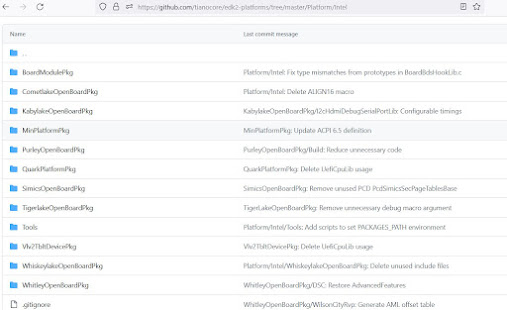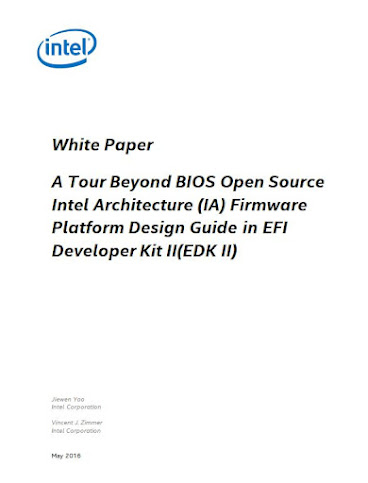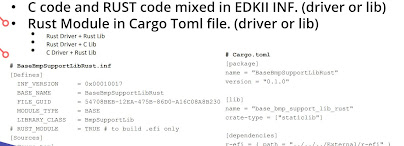Other than emulation platforms like SIMICS or 32-bit IOT Quark, which are all open source, the rest of the platforms are based upon variants of the Intel Firmware Support Package (FSP) https://github.com/intel/fsp
I described the value of open source for security assurance in another venue https://www.intel.com/content/dam/develop/external/us/en/documents/stts003-sf15-stts003-100f-820238.pdf
including the Baytrail-based MinnowBoard and Quark
I was a strong proponent of openness allowing for better security. One caveat I missed was that once the code is out there and bugs are found, then others will all lean in to help fix, at least for shared 'core' code, not https://en.wikipedia.org/wiki/Tragedy_of_the_commons
The challenge at the time was how to structure the code. We used Quark, since it was fully open, to model some of the software practices https://github.com/tianocore-docs/Docs/raw/master/White_Papers/A_Tour_Beyond_BIOS_Open_Source_IA_Firmware_Platform_Design_Guide_in_EFI_Developer_Kit_II.pdf
At this point we only had Atom-based Minnow in the open. During this time we worked w/ the business units to get permission to open up a big core based platform code, namely Kaby Lake, and a Xeon big core server, namely Purley. The work is described in https://github.com/tianocore/edk2-platforms/blob/devel-MinPlatform/Platform/Intel/MinPlatformPkg/Docs/A_Tour_Beyond_BIOS_Open_Source_IA_Firmware_Platform_Design_Guide_in_EFI_Developer_Kit_II%20-%20V2.pdf
This provided an overview of the server work and also a description of the software stacking.
Another view provided the workflow of the open source core on the left, the silicon packages in the middle, and the open source platform code on the right in order to curate a complete solution.
The best description of the overall workflow with a given SOC was described in https://www.intel.com/content/dam/develop/external/us/en/documents/uefi-firmware-enabling-guide-for-the-intel-atom-processor-e3900-series-820238.pdf in 2018
Just as we explicated security best practices in https://link.springer.com/book/10.1007/978-1-4842-6106-4, we did describe some of this platform work that is now embodied as the 'min platform architecture' (MPA) https://github.com/tianocore/tianocore.github.io/wiki/Minimum-Platform-Architecture--MinPlatform.
With the evolution of a min-tree and min platform
Then there is also the 'Tragedy of the Commons' allusion wrt core I mentioned above.
The same story holds for evolution of new techniques like memory-safe languages like Rust into a large extant code base. Although the rewrite of critical libraries in Rust https://cfp.osfc.io/media/osfc2020/submissions/SLFJTN/resources/OSFC2020_Rust_EFI_Yao_Zimmer_NDK4Dme.pdf showed efficacy
given history like https://www.blackhat.com/presentations/bh-usa-09/WOJTCZUK/BHUSA09-Wojtczuk-AtkIntelBios-SLIDES.pdf
the cost of integrating the language in mainline and the hardening since 2009 make it a hard sell. But for 'new code' with tricky attacker-controlled data types, perhaps the dialectic can lean toward embracing language-based security?
Speaking of wisdom of others, some of this work for a min* was motivated by a comment I heard from https://en.wikipedia.org/wiki/Window_Snyder, namely 'the security defender's best weapon is the "delete" key.' Specifically, deleted code cannot have CVE's or a lack of test coverage. So 'min' as a tactic for 'less code' is often a salubrious path to pursue.
Regarding the thread on platforms above, mentioning MPA doesn't mean that there are not other open opportunities beyond EDKII. There are examples such as https://github.com/slimbootloader/slimbootloader/tree/master/Platform
and https://github.com/coreboot/coreboot/tree/master/src/mainboard/intel
You can find info in https://link.springer.com/book/10.1007/978-1-4842-7939-7 https://github.com/Apress/System-Firmware
for slim bootloader
and coreboot, respectively.
Speaking of the various platform code embodiment's, efforts like Universal Scalable Firmware Architecture (intel.com) https://universalscalablefirmware.github.io/documentation/ work to find reuse across these different environments
This work also mentions accommodating Rust-based designs, including https://github.com/oreboot/oreboot, which is mentioned in the first of the two books above https://link.springer.com/book/10.1007/978-1-4842-7974-8, too.
and https://github.com/u-boot/u-boot, too
including its use in https://github.com/openbmc/openbmc
PS
Sometimes my blog posts are like Joyce's Finnegan's Wake where the last sentence and the first sentence of the book overlap. Or maybe a snake eating its tail? Whatever the literary motif or allusion, another of the slides from the 2015 prezo at the top of this post, namely
reminded me of more recent happening in the industry, namely the 2021 prezo from AMI https://www.youtube.com/watch?v=SeiigV8PJPE and the Aptio Open edition. It describes their variant of this 2015 vision for OCP realized in practice in 2021
This leverages the work out of the Open System Firmware (OSF) https://www.opencompute.org/wiki/Open_System_Firmware
Sidebar - what a change between 2018-2023. Ron now at Samsung. David at Amazon. Isaac recently retired from Intel. And Gundrala sadly passed
https://ocp-all.groups.io/g/main/topic/in_memory_of_gundrala/87592963?p=,,,20,0,0,0::recentpostdate/sticky,,,20,1,80,87592963,previd%3D1611775656365391031,nextid%3D1638983329612768441&previd=1611775656365391031&nextid=1638983329612768441. Gundrala and I collaborated quite a bit when he was at Intel, including
and many othersGundrala is missed. It was nice having an opportunity to roll down 156th with him and grab Indian Food across from Crossroads here in Bellevue during his MS (post-Intel) years.
Ok. Back to the topics of open source platform code. So this 'open platform code/mintree' is another 'recent-to-past' binding. In general the 2015 to 2021 hang time of 6 years is not unreasonable. I once recall a software VP in early 2000's telling me that 'nothing significant happens in less than 10 years.' In the world of internet time and AI I suspect the timelines are a bit accelerated, but I have definitely observed that looking for quick wins in the infrastructure space rarely occurs.
PPS
https://twitter.com/kirkbrannock/status/1665121431519367169
saddened me. Kirk this year and Sham last year
have left the building to retirement, or as I sometimes joke "had a sharp enough spoon to dig out of Shawshank." https://en.wikipedia.org/wiki/The_Shawshank_Redemption
Good times working on BIOS with both, Sham being a huge mentor to me starting in 1997. He was sort of the "BIOS Yoda" when I joined Intel. Sham's the guy who did the first SMM BIOS enabling on the 386SL, etc. And I met Kirk in 1998 starting on workstation BIOS, EFI, and then many things platform thereafter, including great design oppty's with both like https://patents.google.com/patent/US7392371B2/en
which ended up landing in https://uefi.org/specs/PI/1.8/V3_Design_Discussion.html#firmware-file-system-format
Or with guru Sham on SMM on https://patents.google.com/patent/US6775728B2/en
that lives on today with things like https://uefi.org/specs/PI/1.8/V4_MM_Protocols.html#mm-mp-protocol.
And Sham also dropped one of my favorite farewell messages, viz.,
As many of you have already heard - after 32+ years at Intel, I have decided to retire and start the next phase of my life’s exciting journey. I had prepared a very long farewell message for all of you, filled with my sage wisdom and list of accomplishments etc. etc. but then, I looked at the address field and it struck me that I still really like most of you on the list – so here is a short version.
For past three decades, I watched technologies change. An amazing Technological Symphony was being played at Intel and I was fortunate enough to be hired into the orchestra as a bell ringer. I hope my cow bell went “ting” at the right time to make the symphony even more brilliant and melodious to the world, and that it helped to harmonize and amplify the brilliant voices around me. Now, a time has come for me to pass on the bell to steadier and younger hands that would ring the bell even more vigorously and timely than I could. As for me, I would gracefully join the audience and keep nodding as you play along taking this complex orchestra to dizzying heights.













































No comments:
Post a Comment